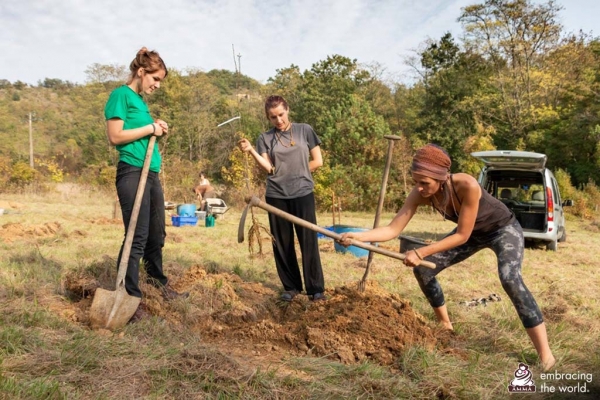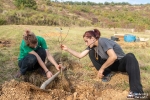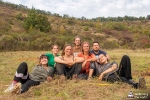“In the last 14 years, AYUDH Europe has organized many spontaneous tree-planting activities, but they were never part of a bigger picture,” explained Robert Westmore from Milan, Italy. Westmore is coordinating the project.
“Following the world trend of being concerned about climate change and environmental care, in particular after the Paris Agreement, our community has encouraged us more and more to design an AYUDH project which aims to take care of Mother Nature.”
Amma is also constantly renewing her concerns about environmental care. In one gathering, she said, “Forests play the most important role in maintaining nature's harmony. Each country should try to protect its remaining forests and plant as many trees as possible. Individually, we should each make a vow to plant one tree a month so that in a year, each person plants 12 trees.”
AYUDH Europe decided it was time to play a bigger role and encourage youth all over Europe to make their society a greener one. Even though the campaign has just started, they have already planted more than 120 trees in four different countries. More initiatives are already scheduled for January and February.
“Our tree-planting initiatives can serve different purposes: creating a community fruit orchard, restoring disturbances in a forest, planting trees in a public garden and so on,” said Westmore. “The first step is always to receive permission and make an agreement with the private landowner or the public administration.”
In this process, the AYUDH team first outlines what roles the trees will play in the community. Then it is time for practical details: how many trees to plant, the species of the seedlings, and collection of all necessary tools and materials.
Westmore elaborated, “The action of digging the holes and putting the trees in the ground is short compared to the work dedicated to the planning process. Since it takes experience and skills to properly plan a tree-planting, we make sure to provide support to each team in these delicate steps. Finally, you meet up one day equipped with supplies and good intentions and you place the trees into what will become their home.”
Tree-planting can be a very expensive process in Europe and local administrations struggle to find the budget for it. Usually the municipalities are very happy when AYUDH approaches them. Westmore says the best thing is that it's an act that lasts a lifetime. It doesn't finish when you are done digging the holes or watering the trees, but continues as the trees grow and mature enough to provide shade, shelter and fruit.
“Our best hope is that our volunteers and the community can enjoy the result of this action for all their life,” said Westmore. “It's not enough to reduce our emissions to save the planet, it's time to make our emissions ‘negative’. We need to plant as many trees as necessary to absorb the carbon dioxide footprint we produce to maintain our lifestyle. This action is necessary to fight back the greenhouse effect and global warming.”
Westmore continued, “We also believe that tree-planting is a very effective action for forming a community of young and concerned citizens. Through tree-planting you literally create the change you want to see with your own hands. When young people become sensible about their societal conditions, they learn the power they have to be make a positive change come true.”
Trees for Peace also sees tree-planting as a way to teach subjects beyond planting itself. Participants are learning skills like event planning, organization, budget management and leadership.
“You have to learn to see in the future of 5, 10, 20 years and imagine what your trees will become. You have to consider concretely what the result of your actions will be. This teaches the values of perseverance, patience and how to deal with unexpected events,” Westmore concluded.








